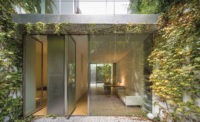Madrid
The interweaving of indoor and outdoor spaces in #house#1.130, by Madrid architect Estudio Entresitio, recalls the condensed landscapes of classical Chinese gardens in Suzhou: tightly framed vistas are crossed in close succession by multiple spatial events–glazed pavilions, light wells, bridges, terraces, beds of vegetation, a covered pathway angling slightly out of view. Like many of those Chinese gardens, this 6,200-square-foot house is shoehorned onto a small site (in this case, a quarter-acre plot in a leafy Madrid suburb) and hemmed in on either side by neighboring houses (occupied by the client's mother and sister, respectively). So the house turns inward, its principal spaces and circulation paths looking back and forth among themselves. The project's odd name is a code the architect uses to maintain the client's anonymity.
The parcel originally formed part of the yard of the mother's rather conventional mansion, an oasis of greenery that the architect felt was important “to give back to the site,” says José María Hurtado, a partner in Entresitio together with his sister, María Hurtado (currently teaching at the New Jersey Institute of Technology), and César Jiménez. The firm kept the house low to the ground, following the 10-foot slope down from the street, and covered its various levels—including the main roof—with planting beds.
Hurtado explains that interior spaces were placed “in their best location,” in terms of orientation and views. The larger footprint of the lower floor, housing bedrooms and the garage, forms a kind of plinth, topped with terraces and planting areas that serve the living spaces above. Living spaces are aligned along the long southern exposure, with large windows protected by motorized vertical louvers that the architect custom-designed (it also served as a contractor for the house). The kitchen and other service spaces are located on the northern facade, where translucent polycarbonate panels enclose the staircase and garage.
The architect divided the upper floor into two zones, with the main entry in between. The living room overlooks the trees at the back of the parcel. At the front, the dining room—an almost independent pavilion of floor-to-ceiling glass—is set in a handsome court with a covered terrace and pool presided over by one of the site's original holm oak trees. Connected by indoor and outdoor passages, and separated by a terrace and light well to the lower level, the two zones are given a sense of unity by the regular rhythm of the exposed steel crossbeams supporting the roof. These extend beyond the walls in many places to form pergolas and create a counter-rhythm to the staccato shadow patterns cast by the vertical louvers.
On the lower levels, the light trenches that cut into the terrain follow and reinforce the paths of circulation spaces inside. They bring daylight to the children's bedrooms under the dining room wing and to the servants' quarters in the basement, under the master bedroom. “Most of the bedrooms are like cabins in a garden, with a patio on one side and greenery on the other,” Hurtado explains. On both of the main floors, the various spaces push in and out at different angles along the southern facade. With its white metal louvers and white corrugated concrete walls (finely cast using formwork invented by the architect to match the vertical striation of the louvers), the overall composition of setbacks and pavilions recalls a whitewashed village on a hillside, an effect that should become more pronounced as the rooftop gardens grow.
The ribbons of greenery, which extend below-grade to the light wells and run up a ramp to the roof, are just one element in the design's multidimensional knitting together of inside and out. In its first proposal to the client, the architect developed this strategy even more intensely. It was based on a honeycomb of hexagonal rooms and patios that was systematically distorted in size and shape according to programmatic requirements. Each distortion created adjustments in adjacent hexagons, following a mathematical system known as a Voronoi diagram. The proposal pursued a line of investigation that the architect had begun in previous projects, such as the San Blas Health Care Center in Madrid, where it scattered 14 miniature patios through a matrix of corridors, waiting areas, and examination rooms.
When the client balked at this radical design, the team eliminated the interior patios and transformed spaces into more conventional rectangular rooms, although the jostling of volumes and angled walls retains traces of the bubble-like hexagons, transmitting a sense of pressure and distortion, like puzzle pieces pushed together on an undersized game board.
While the complexity of the design produces a few awkward spots–excessively long and narrow corridors on the bedroom level, for example, and a rather tight entry foyer–its spatial richness compensates for these drawbacks.
With its roots in the hexagonal plan, the project belongs to a growing trend in Spain of designs based on the conglomeration of independent cellular units, as seen in Luis Mansilla and Emilio Tuñón's MUSAC Museum in León, Spain. This cellular strategy actually dates back to Spain's Organicist movement in the late 1950s and '60s, when architects such as Fernando Higueras and the team of Ramón Vázquez Molezún and José A. Corrales, inspired by Frank Lloyd Wright, built houses with spreading, horizontal plans that fused landscape and building. But while the Organicists used the extended eaves of low hip roofs to create deeply shaded spaces as a response to Spain's harsh summers, the stark white forms and sheer glazed walls of the #house#1.130 are closer to the original spirit of the Modern movement, their clearly modeled volumes resplendent under a nourishing sun.
Completion Date: April 2013
Size: 6,200 square feet
Total construction cost: withheld
Architect:
estudio.entresitio
www.entresitio.com
estudio@entresitio.com
Madrid: Gran Vía 33, 7ºI
28013 Madrid, Spain
+34 91 7010330
New York: 134 West 86th st #4A
NY, NY10024
+1 917 870 1092
PeopleOwner: private client
Architect:
Personnel in architect's firm who should receive special credit: (Internal collaborators entresitio: Miguel Crespo, Marco Plazzogna, Anne-Dorothée Herbot, Mia Molato)
Engineer(s): EMP consultant: Geasyt SA Construction supervisor: Guillermo Parilla
Consultant(s):
General contractor:
Photographer(s): |
Products
Structural system
Manufacturer of any structural components unique to this project:
Exterior cladding Contractor: Carpinterias GIC Teofilo SL. www.teofilosl.es
Other cladding unique to this project: Permeable wall: fix and moveable white metal shutters: Concordio Pérez S.L.. Locksmith
Roofing
Doors |



















Post a comment to this article
Report Abusive Comment